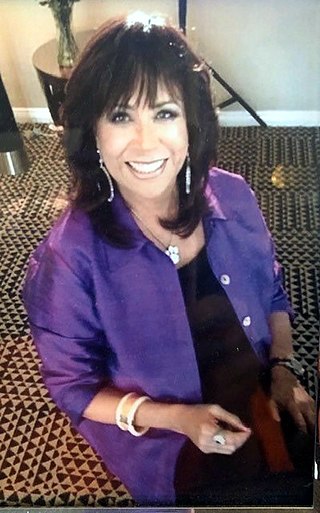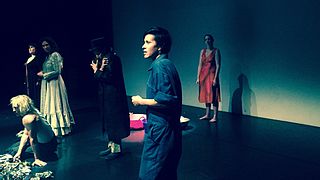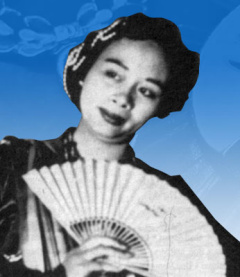Related Research Articles
Ana Mendieta was a Cuban-American performance artist, sculptor, painter, and video artist who is best known for her "earth-body" artwork. She is considered one of the most influential Cuban-American artists of the post–World War II era. Born in Havana, Cuba, Mendieta left for the United States in 1961.

The Centro Cultural de la Raza is a non-profit organization with the specific mission to create, preserve, promote and educate about Chicano, Mexicano, Native American and Latino art and culture. It is located in Balboa Park in San Diego, California. The cultural center supports and encourages the creative expression “of the indigenous cultures of the Americas.” It is currently a member of the American Alliance of Museums.

Grace Nono is a Filipino singer, known for her musical style based on traditional Filipino rhythms. She is also an ethnomusicologist, scholar of Philippine shamanism, and cultural worker.

Denise Donna Nicholas is an American actress. Nicholas played high-school guidance counselor Liz McIntyre on the ABC comedy-drama series Room 222 and Councilwoman Harriet DeLong on the NBC/CBS drama series In the Heat of the Night.
Lauren Raine is a painter, sculptor, mask artist, performance artist, author, and choreographer with work in international private and public collections. She was Director of Rites of Passage Gallery in Berkeley, California.
Dan Kwong is an American performance artist, writer, teacher and visual artist. He has been presenting his solo performances since 1989, often drawing upon his own life experiences to explore personal, historical, and social issues.
Barbara Turner Smith is an American artist known for her performance art in the late 1960s, exploring themes of food, nurturing, the body, spirituality, and sexuality. Smith was part of the Feminist Movement in Southern California in the 1970s and has collaborated in her work with scientists and other artists. Her work has been widely exhibited and collected by major museums including the J. Paul Getty Museum, the Hammer Museum, MOCA, LACMA, and the Art Institute of Chicago.
Asian American theatre refers to theatre written, directed or acted by Asian Americans. From initial efforts by four theatre companies in the 1960s, Asian-American theatre has grown to around forty groups today. Early productions often had Asian themes or settings; and "yellowface" was a common medium for displaying the perceived exoticism of the East in American performance. With the growing establishment of second-generation Asian-Americans in the 21st century, it is becoming more common today to see Asian-Americans in roles that defy historical stereotypes in the United States.
Diane Rodriguez was an American theatre artist who directed, wrote and performed. An OBIE Award winning actress, she was known for using comedy to confront various forms of oppression, often with special attention to issues of gender and sexuality.

James Luna was a Puyukitchum, Ipai, and Mexican-American performance artist, photographer and multimedia installation artist. His work is best known for challenging the ways in which conventional museum exhibitions depict Native Americans. With recurring themes of multiculturalism, alcoholism, and colonialism, his work was often comedic and theatrical in nature. In 2017 he was awarded a Guggenheim Fellowship.
Patssi Valdez is an American Chicana artist. She is a founding member of the art collective Asco. Valdez's work represents some of the finest Chicana avant-garde expressionism which includes but not limited to painting, sculpture and fashion design. She lives and works in Los Angeles, California.

Brenda Wong Aoki is an American playwright, actor and storyteller. She creates monodramas rooted in traditional storytelling, dance movement, and music. Aoki's work combines Eastern and Western narratives and theatrical traditions such as noh, kyogen, commedia dell'arte, modern dance, Japanese drumming, and American jazz. Most of her performances express themes of history, mixed race, home, gender, and mythology. Aoki is a founding faculty member of the Institute for Diversity in the Arts at Stanford University. Aoki and her husband Mark Izu, an Emmy-winning jazz music composer, are the founders of First Voice, a San Francisco-based nonprofit arts organization.

Senga Nengudi is an African-American visual artist and curator. She is best known for her abstract sculptures that combine found objects and choreographed performance. She is part of a group of African-American avant-garde artists working in New York City and Los Angeles, from the 1960s and onward.
Kim Anno is a Japanese-American artist and educator. She is known for her work as an abstract painter, photographer, and filmmaker. Anno has served as a professor, and as the chair of the painting department at the California College of the Arts in San Francisco.
Milta Ortiz is a bilingual, bicultural playwright, poet, and performer.
Stephanie Anne Johnson is an American mixed media artist. Many of her works are site-specific, open-air art installation pieces.

The Highways Performance Space is a performance venue in Santa Monica, California, which focuses on new works and alternative pieces. The organization is a space for LGBTQ artists to experiment with form and content. Performed work includes theatre, music, dance, spoken word, interactive media, and visual arts.
Kaya Press is an independent non-profit publisher of writers of the Asian and Pacific Islander diaspora. Founded in 1994 by the postmodern Korean writer Soo Kyung Kim, Kaya Press is housed in the Department of American Studies and Ethnicity at the University of Southern California.

Jeanelle Mastema is a Mexican American experimental body and performance artist from Boyle Heights, California. Mastema incorporates ritual into her work through play piercing, hook suspensions, live magick and sacred objects. She performs internationally, solo and in groups, often acting as a medium for group intentions or a symbolic altar for channeling energy. Through performance, Mastema enters into a meditative head space to disconnect from mundane consciousness. Her major influences include: Butoh, Kenneth Anger, Surrealism, Psychedelic Art, the Viena Actionists, Kembra Pfaher, Leonora Carrington and Alejandro Jodorowsky. She also works as the West Coast sales manager for an adult novelty toy store. She also worked at the Pleasure Chest for many years and is featured in a film called, Thank You Come Again, based on working there.

Lucrecia Faustino Reyes-Urtula was a Filipino choreographer, theater director, teacher, author and researcher on ethnic dance. She was the founding director of the Bayanihan Philippine National Folk Dance Company and was named National Artist of the Philippines for dance in 1988.
References
- ↑ "About AAIR 2013 – Denise Uyehara". Pomona College. Retrieved 1 February 2014.
- ↑ Fusco, Coco (1 July 1995). "Sacred Naked Nature Girls". Bomb Magazine (52).
- ↑ Stephenson, Andrew (1999). Jones, Amelia (ed.). Performing the body/performing the text (Transferred to digital print. ed.). London: Routledge. pp. 199–206. ISBN 0415190592.
- 1 2 3 "Denise Uyehara" . Retrieved 14 November 2014.
- ↑ Isenberg, Barbara (February 14, 1993). "Denise Uyehara: Testing Her Survival Skills - On the Job". Los Angeles Times. Retrieved 1 February 2014.
- ↑ Cheng, Meiling (2003). ""BIG HEAD. By Denise Uyehara. With additional words by Masamori Kojima, Edina Lekovic, Shady Hakim, Lulu Emery, Tamadhur Al-Aqeel, Lillian Nakano. Highways Performance Space, Santa Monica"". Theatre Journal. 55 (3): 518–519. doi:10.1353/tj.2003.0101. S2CID 192182735.
- ↑ Kathleen, Allen (March 31, 2017). "Review: Borderland's 'Shooting Columbus' disturbing, beautiful". Tucson.com. Retrieved Nov 15, 2021.
- ↑ "Denise Uyehara" . Retrieved 30 October 2014.
- ↑ "Shooting Columbus - MAP Fund". 28 April 2015.
- ↑ "Without Papers". Tucson Weekly. Retrieved 30 October 2014.
- ↑ "Ancestral Cartographic Rituals (work-in-progress) | James Luna and Denise Uyehara".
- ↑ "Denise Uyehara" . Retrieved 30 October 2014.
- ↑ "Denise Uyehara" . Retrieved 30 October 2014.
- ↑ Lei, Daphne (July 2010). "Ruptures Within and Without: Pageantry – A Work in Progress by Denise Uyehara and Sri Susilowati". Theatre Research International. 35 (2): 188–192. doi:10.1017/S0307883310000118. ISSN 0307-8833. S2CID 162370720.
- ↑ Xu, Wenying (2012). Historical Dictionary of Asian American Literature and Theater.
- ↑ Hart, Hugh (February 18, 2003). "Art of urgency; A new performance work focuses on the plight of Arab Americans". Los Angeles Times. Retrieved November 15, 2021.
- ↑ Jennifer, Ta (May 5, 2009). "Project Addresses Mistranslation". Daily Bruin. Retrieved Nov 15, 2021.
- ↑ Kina, Laura (July 6, 2020). "Ancestral Cartography: Trans-Pacific Interchanges and Okinawan Indigeneity". Brill. 6 (1–2): 48–70. doi:10.1163/23523085-00601004. S2CID 225545576.
- ↑ "'Archipelago' Combines Okinawan Myth, Yaqui River Valley History". Rafu Shimpo. Feb 10, 2012. Retrieved November 15, 2021.
- ↑ "Los Angeles Goes Live: Performance Art in Southern California 1970-1983".
- ↑ Olivas, Mary (January 23, 2014). "Performance Explores Subtle Themes of Immigration". AZPM. Retrieved November 15, 2021.
- ↑ "Ancestral Cartographic Rituals (work-in-progress) | James Luna and Denise Uyehara". November 29, 2017. Retrieved November 15, 2021.
- ↑ "Asian American Studies" . Retrieved 30 October 2014.